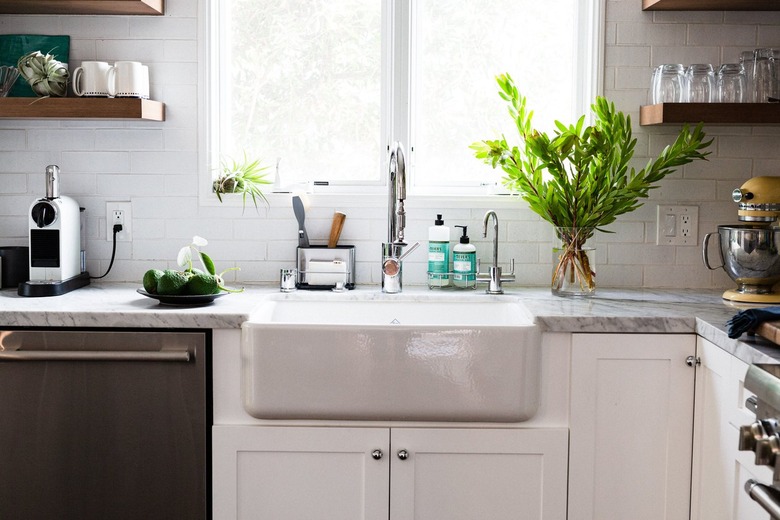Farmhouse Sink Vs. Apron Sink: What Are The Differences?
Think of a rural kitchen in the days before running water, and you'll probably picture a washstand, a forerunner of the modern kitchen counter. In your mind's eye, the basin may be sitting on top of the washstand, but it's also easy to visualize a basin recessed in the stand, with the front slightly protruding, because that's how many of them were back then. Putting a basin inside the cabinet lowered it and made it easier to wash clothes and dishes.
Fast forward to the 21st century and homeowners will find more than one version of the washbasin, usually mounted in a stylish kitchen cabinet. This type of vessel is now known as a farmhouse sink because it harkens back to the days of our forebearers, but it's a totally modern amenity. While some people also call it an apron sink because of the large front panel that extends outward past the edge of the cabinet and down below the countertop, farmhouse and apron sinks are actually not the exact same thing. Read on to find out the difference between the two.
Is a Farmhouse Sink Still in Style?
Is a Farmhouse Sink Still in Style?
Farmhouse-style sinks are timeless and practical, which makes them enduring. Even though they reference a bygone era, they're considered a modern-day luxury in kitchen design that seamlessly marries functionality and style. Their large size renders them a workhorse item that also manages to act as an understated focal point in culinary spaces.
Historically, farmhouse sinks were constructed from cast iron or porcelain, making them particularly fitting for more approachable and laidback aesthetics — like traditional, bohemian, craftsman, and of course, farmhouse — to name a few. However, now they are available in a variety of sink materials, including stainless steel, copper, fireclay, and natural stone, which makes them appropriate for more modern and contemporary styles. Farmhouse sinks, when crafted from one of these updated materials, are actually referred to as apron or apron-front sinks.
Is a Farmhouse Sink an Apron Sink?
Is a Farmhouse Sink an Apron Sink?
Many people use the terms "farmhouse" and "apron" or "apron-front" sink interchangeably, but they're actually not the same. Both sinks share similar characteristics, namely their deep basins, large size, and exposed fronts, but purists will argue that it isn't a true farmhouse sink unless it's made from a certain material (porcelain or fireclay) and has an integrated workstation.
Farmhouse Sink vs. Apron Sink
Farmhouse Sink vs. Apron Sink
Farmhouse and apron sinks are beloved by amateur and skilled cooks alike for their ample bowl size (anywhere from 20 to 60 inches in length and 9 to 10 inches deep), which facilitates washing dishes and large pots. This type of sink can even be used to clean clothes and bathe young children or small pets. While most kitchen sinks are surrounded on all sides by countertops and cabinetry, farmhouse and apron sinks stand apart because they have an exposed front (also known as the apron). Once purely utilitarian (designed to extend slightly beyond the cabinetry so that any water running down the front of the sink lands on the floor and not on the cabinets), today that exposed front is a design consideration in its own right and is available with details such as fluting, ridges, or patterns.
Farmhouse sinks originated in Ireland and Great Britain in the 17th century when running water was scarce — the bigger sink basins could hold large quantities of fetched water. These large work sinks made their way to American kitchens in the 1920s and, in addition to a large basin, included an integrated backsplash as well as drainboards and often legs for added support.
When all is said and done, apron-front sinks are merely a contemporary farmhouse sink: They share the telltale exposed front-facing panel that farmhouse sinks have, but are constructed from updated materials like stainless steel, cast iron, and natural stone. And although they evolved from farmhouse sinks of yore, apron sinks are more streamlined and don't have a wall-mounted backsplash or connected workstation. So an apron-front is essentially a subset or type of farmhouse sink.
Are There Any Differences Between Farmhouse Sinks and Apron Sinks?
Are There Any Differences Between Farmhouse Sinks and Apron Sinks?
Aside from the material and the seamless inclusion of a backsplash and drainboard, true farmhouse and apron sinks differ in their installation requirements. A backsplash makes it possible to secure a farmhouse sink to the wall and the addition of legs add needed support to the front. Apron-front sinks are available as undermount and top-mount/drop-in styles, and due to their size and heft, need more support than clips holding it to the countertop. The support structure is typically built into the cabinet, and the structure — along with the oversize sink itself — may eat up valuable storage space. You have to slide an apron sink in from the front, which means the front of the cabinet has to be notched to create space for it. While that's usually possible, it can be difficult and expensive.
Additionally, apron-front sink hardware needs to be wall-mounted or drilled into the countertop behind the sink, while farmhouse sinks come with holes pre-drilled into the deck or backsplash.
Just a Few Things to Keep in Mind
Just a Few Things to Keep in Mind
Farmhouse and apron or apron-front sinks continue to be a kitchen staple due to their ample size and their statement-making quality. Although they're often referred to synonymously, there are slight differences that distinguish the two styles: Traditional farmhouse kitchen sinks fall under the apron-front category and have an integrated wash station or drainboard and high backsplash. They're fashioned from porcelain and cast iron, while apron sinks are a modern moniker that refers to sinks with an exposed front fashioned from a variety of materials including stainless steel, natural stone, and copper.





